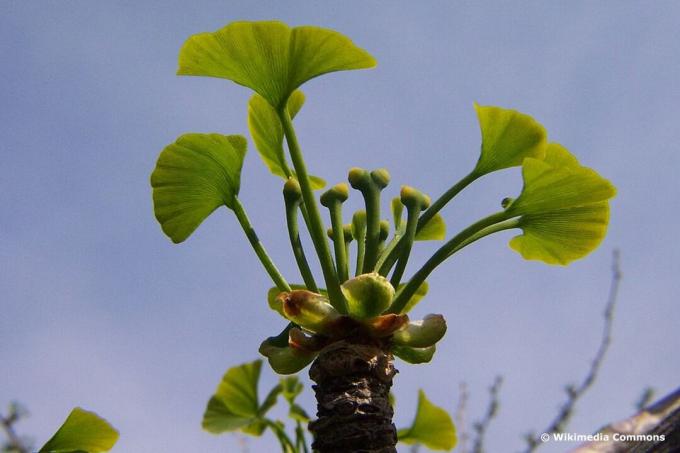
table of contents
- Basics
- Heyday
- Promotion of flower formation
- Flower characteristics
- Toxicity
- Medicinal properties of flowers
- frequently asked Questions
The one originally from China Ginkgo (Ginkgo biloba) is now also at home in Central Europe. Few people know that the ginkgo has a flower. Here you can find out everything you need to know about the flowering period and special characteristics.
In a nutshell
- Ginkgo trees always have female or male flowers
- flowers only after many years
- gender-dependent traits
Basics
Basically, a ginkgo does not have a flower with a classic appearance. It has no flower cover and therefore falls under the so-called strobilis. This refers to (a kind of) cones, such as those that are also formed by conifers. They include different shapes of blooms with elongated, woody axes. Nevertheless, the name of ginkgo blossoms is common in local areas, at least among those who even know that the tree bears blossoms.

Heyday
The flowering period usually begins in March before the leaves form. Male specimens usually bloom first. The flowering period then extends well into April. Depending on the weather, a ginkgo will bloom until May.
First flower formation
The ginkgo plant takes a long time with the first flower formation. It takes at least 20 years and sometimes 35 years. This is based on sexual maturity, which takes this period of time for their development.
Tip: If you want to enjoy the autumn color through the fruits of a ginkgo, planting male and female specimens promising if there is no opposite-sex ginkgo plant in the immediate vicinity is available.
Promotion of flower formation
There are hardly any measures that promote faster flowering. Only good care, especially with regard to pruning, will keep the tree healthy and strong. These are basic prerequisites for it to form flowers at all for reproduction or pollination and the necessary flowers. If sick, weakened ginkgos lack energy and vigor to grow, flower formation does not occur or is only marginally present. Therefore, the Asian tree should be lighted slightly every spring so that light and air can get through the branches.

Flower characteristics
- light brown terminal buds arranged like scales with a diameter between two and five millimeters
- subsequently green-yellowish spike-like inflorescences
- later development into cat-shaped flowers
- Flower size: male between two and three centimeters; female few millimeters
- later stage of maturity: males fall off; female educate themselves to mirabelle-like fruits / nuts
- The most striking difference between male and female flowers: the latter are usually twos on a forked stalk
- Stem length: between one and 1.5 centimeters
- Place of flower formation: on the axils of the lower and deciduous leaves of perennial short shoots (male further inside)
Note: Did you know that in this type of tree, male pollen grains are transported to the female flowers by the wind? The pollination results in fertilization, which takes place between the end of August and the end of September.
Toxicity
So far, no evidence of toxicity of the ginkgo flower has been found. The regional poisoning centers and information centers for poisonous plants do not list ginkgos. This means that to date there has been no case of possible poisoning through consumption or contact with parts of plants such as the flower. A health hazard to dogs and cats can therefore also be ruled out. Nevertheless, consumption should be avoided.

Medicinal properties of flowers
The ginkgo blossom has no healing or health-promoting properties. Only the seeds that develop in it are said to have a circulation-promoting effect.
frequently asked Questions
If you have thinned the tree regularly, you should start from the 20th Year of life then only thin out the branches that are really necessary. However, there is nothing to prevent you from cutting off some of the buds. In that year there will be fewer flowers, but you will know it for the following year and can adjust the pruning accordingly.
The age can only be determined approximately by the annual height. If your ginkgo plant is in an optimal location and is healthy, the average growth rate for small varieties is between three and four centimeters. Large varieties grow on average between 30 and 40 centimeters per year. If you measure your tree, you can roughly estimate how old it is and when the earliest flowering can be expected.
No. As a rule, of the two, only one ginkgo flower is capable of fertilization. Only one fruit will develop from this.
